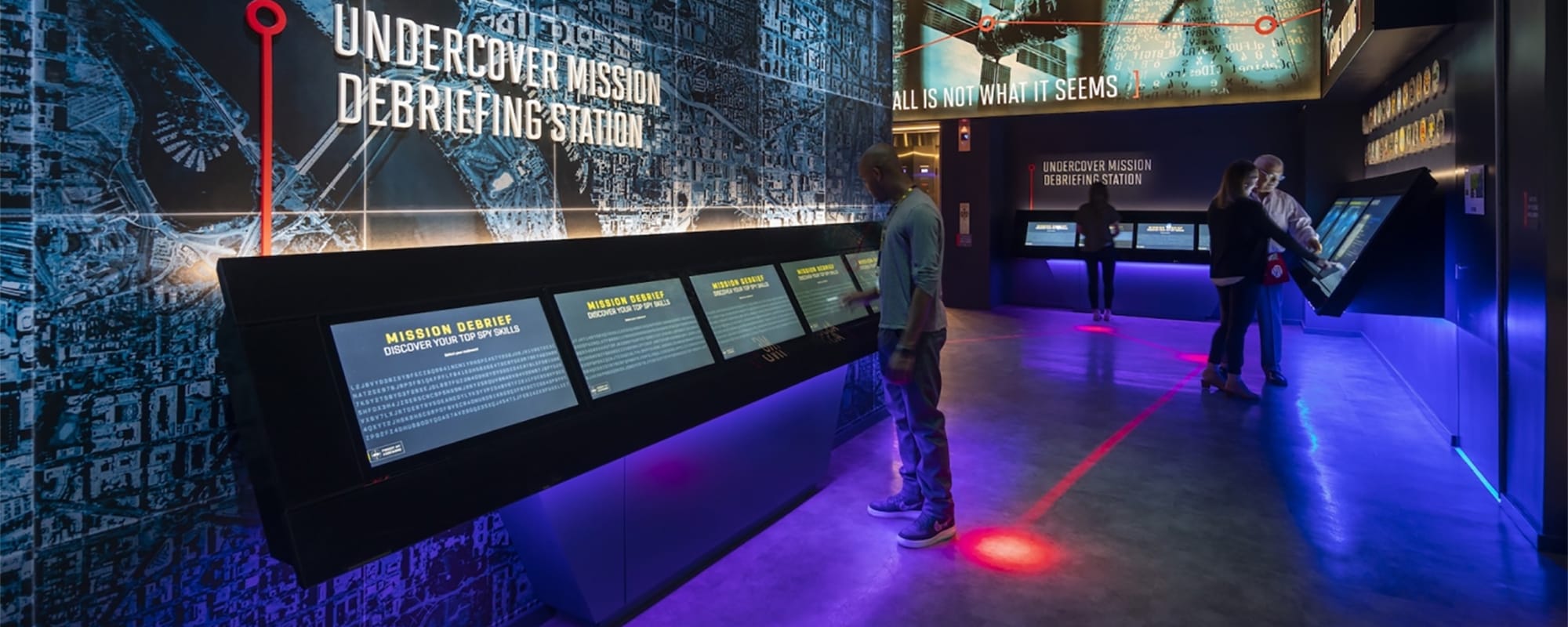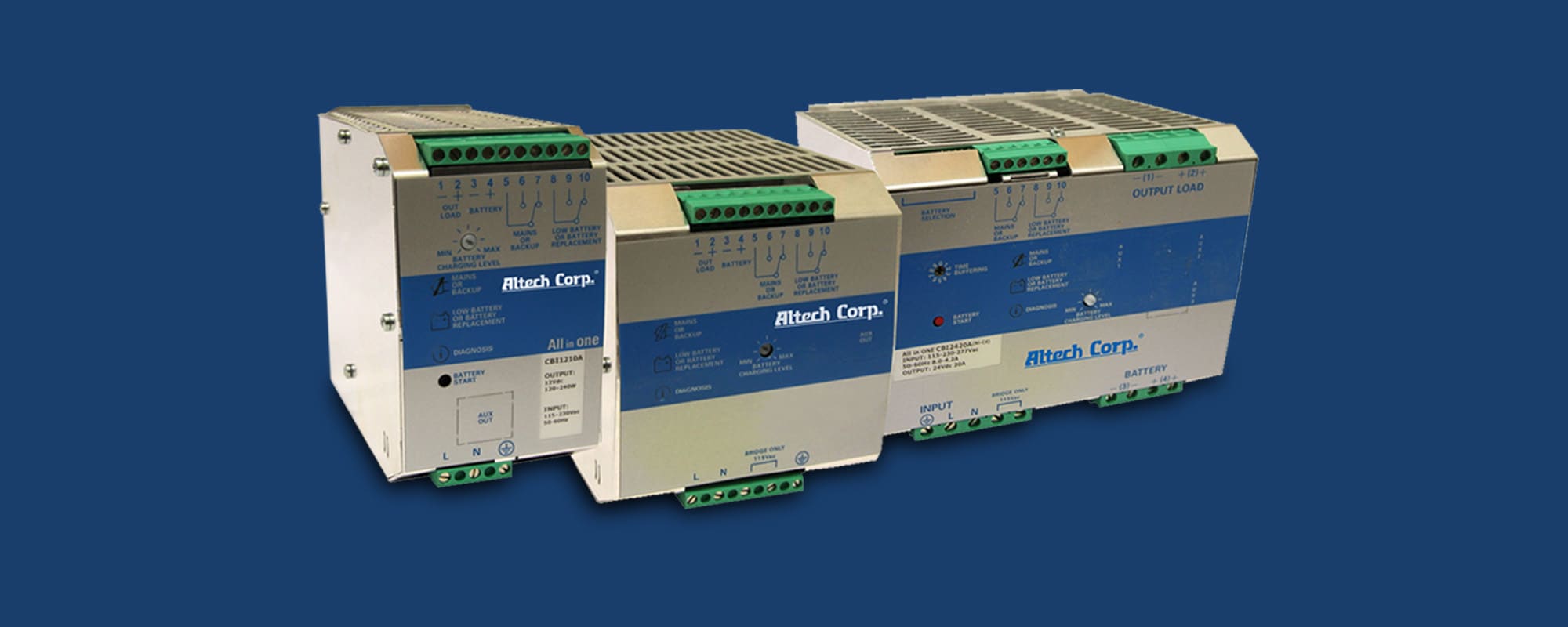Benjamin Hawks, Product Manager – Barcode Readers and Verifiers at Omron Automation, introduces traceability, explains why it’s vital for modern manufacturing, traces its evolution, examines the four essential elements of Traceability 4.0, and recommends solutions.
Benjamin Hawks, Product Manager – Barcode Readers and Verifiers, Omron Automation

Complex manufacturing processes require control, regulation, and supervision — or traceability — to ensure quality, safety, and compliance. Traceability allows manufacturers to track and share information about products as they move throughout the supply chain from production and processing to distribution. Being able to readily identify product information including material composition, origin, production history, and location can help you protect your brand, provide you with valuable information for improving your processes, and in certain industries, like food and beverage and pharmaceutical manufacturing, be essential for compliance.
Traceability ensures rigorous quality control by tracking products throughout every stage of the manufacturing and distribution process and providing manufacturers with the opportunity to promptly identify and rectify any defects. It’s also a powerful tool in the ongoing battle against counterfeiting since it makes it easy to verify product authenticity and origin. Both of these benefits foster higher customer satisfaction by ensuring product integrity and transparency and can be key for protecting your brand from allegations, complying with audits, and responding to inquiries.
Traceability also significantly enhances operational efficiency. It can help manufacturers streamline processes by collecting data about the various stages of production. It can reduce waste by making it quick and easy to identify affected products in the event of a recall. And perhaps most importantly, it can be essential for complying with regulations including the Drug Supply Chain Security Act (DSCSA) and identifying contaminated or compromised products before they reach the market.
As such, traceability is one of the most crucial practices for driving efficiency and ensuring quality, safety, and compliance in many of the most demanding manufacturing market segments, including the automotive, food and beverage, medical and pharmaceutical, and electronics manufacturing industries.
Overcoming Market Challenges With Traceability
In the automotive and electronics manufacturing industries, traceability helps prevent the use of both counterfeit and compromised parts that, due to increased globalization, can cause wider-ranging and significantly more expensive recalls. It can also help ensure compliance with regulations pertaining to conflict minerals and restricted substances, like lead, cadmium, and mercury.
In the food and beverage manufacturing industry, traceability can bring operations into compliance with the evolving requirements of the Food Safety Modernization Act (FSMA), prevent unsafe products from entering the market, pinpoint problematic batches to minimize waste in the event of product recalls, and satisfy growing consumer demand for information about the product’s origin, ingredients, and sourcing practices.
The medical and pharmaceutical industry faces many of the same challenges as the food and beverage industry, just with different regulations. There’s also a lot of crossover in the traceability solutions employed to overcome these challenges.
Traceability 1.0 to Traceability 4.0
Traceability practices have come a long way since its inception in the 1970s. Back then, traceability was a novelty rather than a necessity for many industries.
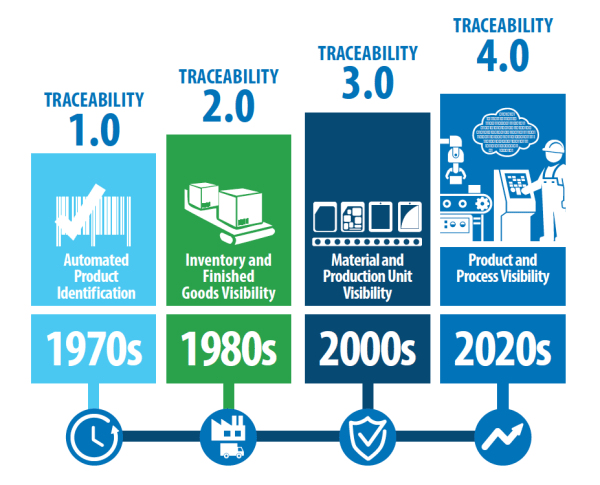
Traceability 1.0 focused on product visibility, using barcodes and barcode readers to automatically identify products and improve production accuracy, efficiency, and productivity.
Traceability 2.0 focused on supply chain visibility, expanding the use of barcodes from end products to materials and from factories throughout the production and distribution process. This era optimized inventory management processes and enabled targeted product recalls, which significantly reduced the cost of quality improvement, offered brands a means of reputation protection, and increased consumer confidence.
Traceability 3.0 focused on line-item visibility, further extending tracking and tracing capabilities from raw materials and products to the sequential works in progress moving through various manufacturing procedures. This comprehensive focus on the material elements of production processes — one of the four key pillars or 4Ms of lean manufacturing: man (people), material, machine, and method — made it easier to ensure product authenticity, provided a strong foundation for anti-counterfeiting programs, and significantly enhanced supply chain security. One of its enduring legacies is direct part marking (DPM), a process used to permanently mark items with product information including serial numbers, part numbers, date codes, and barcodes.
Traceability 4.0, a phrase coined by Omron Automation to represent the current and near-term evolution of traceability practices, focuses on the process visibility enabled by Industry 4.0 technologies and combines product, component, and supply chain tracking with machine and process parameters to simultaneously improve production processes. Traceability 4.0 leverages continuous marking, verifying, reading, and communication processes and advanced technologies including generative AI, augmented reality (AR), data analytics, additive manufacturing, and robotics to integrate and deliver actionable data about people, processes, equipment, and parts. And instead of addressing just one of the 4Ms, it addresses all four, enabling even greater process and efficiency improvements and brand protection.
The Four Essential Elements of Traceability 4.0
The four essential elements of Traceability 4.0 — the processes and practices that define it and facilitate its many benefits — are mark, verify, read, and communicate or MVRC.
Mark: Component identification is at the core of traceability and is generally accomplished using barcodes. These machine-readable identification marks contain comprehensive information about individual parts and act as the glue that connects the physical world to the digital realm. To ensure that these markings are inseparable from their respective objects, manufacturers typically use DPMs — barcodes that are etched, printed, or otherwise a permanent part of an item. Common solutions include inkjet printers, dot peen marking machines, and fiber laser markers, the latter of which leads the others in terms of efficiency and durability and, as an additional bonus, doesn’t use any consumables.
Verify: Ensuring that marked and verified codes can be accurately read throughout the production process is another essential element of Traceability 4.0. Read failures can delay or even shut down a production. So, given the critical information that these markings convey it’s necessary to assess and verify the quality of the marking using key ISO standards and ensure that it conveys the correct data. This verification process is executed using barcode verifiers capable of verifying DPMs as well as 1D and 2D printed barcodes.
Barcode verification is especially vital in the automotive, electronics, and medical manufacturing industries. The barcodes in these industries need to be verified against international standards such as ISO/IEC 29158 to ensure that they’ll remain legible throughout the part lifecycle. This process ensures that the information they contain is accessible to those who need.

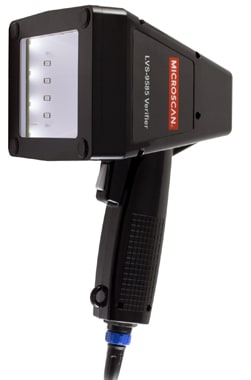
Omron Automation’s LVS-9585 handheld DPM barcode verifier is an excellent example of a multifunctional, globally relevant solution with comprehensive quality analysis and reporting features. This one tool can verify DPMs to ISO, MIL-STD-130, and GS1 standards and printed barcodes to ISO/IEC, ANSI, GS1, and USDI print quality standards. It can also verify 2D codes including multi-row and matrix codes, inspect all nine of the ISO (ANSI) parameters in linear (1D) codes, and provide exportable Excel or SQL database reports for all parameters per ISO/IEC and MIL-STD-130N specifications.
The LVS-9585 features advanced lighting and software capabilities, including an auto-find feature that helps users find DPMs within the field of view. It also supports multi-sector verification for multiple barcodes and GS1 AI content and automatically selects the lighting settings that work best with each DPM and material substrate. Additional features include an NIST-Traceable Calibrated Conformance Standard Test Card for calibrating the system and support for 15 languages with the ability to add more.
Read: The third pillar of the MVRC Traceability 4.0 process is accurately reading barcode data. Solutions for this step include industrial barcode readers and smart cameras equipped with intelligent inspection software that can read small and even damaged codes.
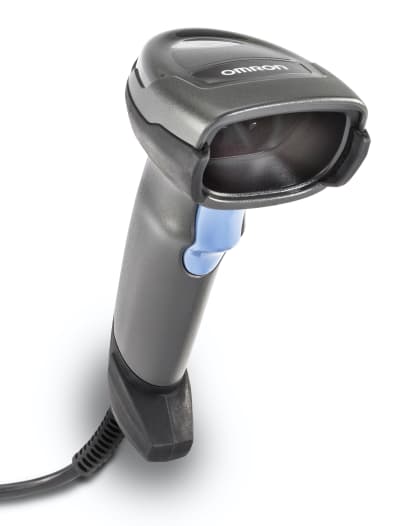
Industrial barcode readers or imagers equipped with highly advanced decoding algorithms can ensure that even when part of a DPM gets damaged, the data isn’t lost forever, which is vital to reliably preventing production delays and downtime. Omron’s powerful, compact, and user-friendly V410-H high-resolution handheld barcode reader family, for instance, is equipped with proven X-Mode scanning algorithms that allow users to reliably read even the smallest and most difficult barcodes and DPMs. There are fixed-mount options too, like Omron’s MicroHAWK V420 serial/USB miniature barcode readers and MicroHAWK V430 Industrial Ethernet barcode readers. These ultra-compact barcode imagers support flexible integration and adaptation with a series of accessories and software features including X-Mode decoding algorithms, enhanced password protection for improved cybersecurity, and advanced data output formatting. They are also available with a liquid lens autofocus feature, which improves focusing speed and focal length. The V420 series supports serial, USB 2.0, and Ethernet over USB communications and reliably outperforms competing solutions in its class. The V430 series supports EtherNet/IP, Ethernet, TCP/IP, and PROFINET communications and is the smallest IP65/67-rated true Industrial Ethernet barcode reader on the market.
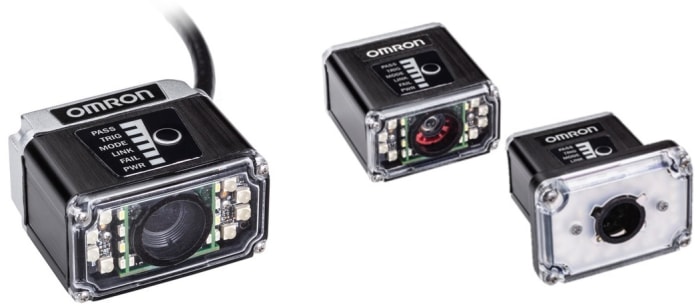
Smart camera solutions are available with machine vision tools that allow them to add industrial inspections to the barcode reading functionality. Examples include Omron’s rugged and ultra-compact MicroHAWK F430 Industrial Ethernet smart cameras and the new F440 user-configurable smart cameras, both of which include the AutoVISION intuitive setup and configuration tool and feature all of the same wiring. The F430 cameras are the smallest IP65/67 true Industrial Ethernet cameras available on the market, while the F440 cameras are available with user configurable lensing and lighting options.
Communicate: The final essential element of Traceability 4.0 is the ability to transmit all of the traceability data captured by readers to systems and devices that allow manufacturers to act on that information. This communication process is vital to identifying process bottlenecks and the source of production failures as well as to implementing targeted product recalls. Machine automation controllers are one of the most commonly deployed traceability communication solutions. They are designed to facilitate complete process control, boost system flexibility, and enhance overall traceability performance and are typically used to send data to manufacturing execution system (MESs) or enterprise resource planning (ERP) systems.
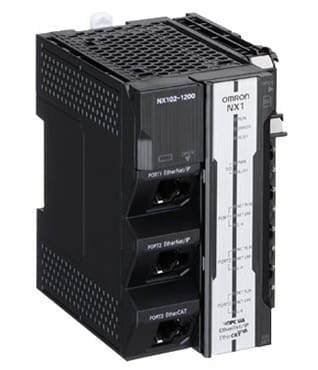
The Sysmac NJ501 Machine Automation Controller (MAC) is Omron’s flagship controller for robust safety, accurate motion, and transparent control. It features a powerful Intel Atom processor that delivers proven performance in harsh environments and is significantly more adaptable and scalable than traditional but rigid ASIC-based architectures. It also comes standard with OPC UA server functionality to better support data exchange between machines and from machines to IT systems. Another solution, its NX102 MAC (pictured here), is engineered to decrease IIoT implementation time by capturing multi-vendor data using native communication networks, reduce the installation costs and delayed refresh rates associated with managed switches for motion control, decrease programming time with the integrated Sysmac Studio development environment, and efficiently consolidate and transmit data to a central location in a web server without additional licenses or computers to broker data.
Implement Traceability 4.0 for Industry 4.0 with Solutions from Omron and RS
Traceability, or tracking and sharing information about products as they move throughout the supply chain from production and processing to distribution, is vital for a growing number of industrial market segments. And thanks to the proliferation of Industry 4.0 technologies, traceability technologies can do more than ever. Traceability 4.0 leverages the enhanced process visibility enabled by Industry 4.0 technologies and combines product, component, and supply chain tracking with machine and process parameters to ensure quality, safety, and compliance while simultaneously improving production efficiencies.
The four pillars of Traceability 4.0 are mark, verify, read, and communicate, and Omron and RS offer a wide range of products optimized to accurately and reliably execute these tasks in harsh industrial environments. Omron is highly experienced in helping manufacturers in various industries overcome traceability challenges with flexible, user-friendly, and cost-effective solutions that seamlessly integrate into existing production lines and works closely with RS to support manufacturers interested in leveraging the many improvements these products enable.
RS offers a wide variety of Omron Automation’s traceability solutions, including barcode verifiers, barcode scanners, barcode readers, smart cameras, and machine automation controllers. For more information about Omron’s Traceability 4.0 solutions, please visit the links embedded here. For assistance identifying and deploying Omron Traceability 4.0 solutions optimized for your smart manufacturing facility, please contact your local RS representative at 1.866.433.5722 or reach out to the RS technical product support team.

